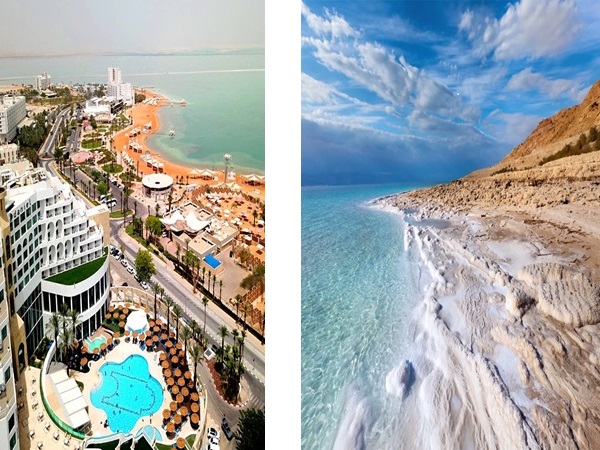Informations
Names
The English name "Dead Sea" is a calque of the Arabic name Bahr or al-Bahr al-Mayyitⓘ (البحر الميت), itself a calque of earlier Greek (Νεκρά Θάλασσα, Nekrá Thálassa) and Latin names (Mare Mortuum) in reference to the scarcity of aquatic life caused by the lake's extreme salinity. The name also occasionally appears in Hebrew literature as Yām HaMāvet (ים המוות), 'Sea of Death'.
Historical English names include the Salt Sea, Lake of Sodom from the biblical account of its destruction and Lake Asphaltites from Greek and Latin. Because of the large volume of ancient trade in the lake's naturally occurring free-floating bitumen, its usual names in ancient Greek and Roman geography were some form of Asphalt Lake (Greek: Ἀσφαλτίτης or Ἀσφαλτίτις Λίμνη, Asphaltítēs or Asphaltítis Límnē; Latin: Lacus Asphaltites) or Sea (Ἀσφαλτίτης Θάλασσα, Asphaltítēs Thálassa).
Geography
The Dead Sea is an endorheic lake located in the Jordan Rift Valley, a geographic feature formed by the Dead Sea Transform (DST). This left lateral-moving transform fault lies along the tectonic plate boundary between the African Plate and the Arabian Plate. It runs between the East Anatolian Fault zone in Turkey and the northern end of the Red Sea Rift offshore of the southern tip of Sinai. It is here that the Upper Jordan River/Sea of Galilee/Lower Jordan River water system comes to an end.
The Jordan River is the only major water source flowing into the Dead Sea, although there are small perennial springs under and around the Dead Sea, forming pools and quicksand pits along the edges. There are no outlet streams.
The Mujib River, biblical Arnon, is one of the larger water sources of the Dead Sea other than the Jordan. The Wadi Mujib valley, 420 m below the sea level in the southern part of the Jordan valley, is a biosphere reserve, with an area of 212 km2 (82 sq mi). Other more substantial sources are Wadi Darajeh (Arabic)/Nahal Dragot (Hebrew), and Nahal Arugot [de] that ends at Ein Gedi. Wadi Hasa (biblical Zered) is another wadi flowing into the Dead Sea.
Rainfall is scarcely 100 mm (4 in) per year in the northern part of the Dead Sea and barely 50 mm (2 in) in the southern part.[22] The Dead Sea zone's aridity is due to the rainshadow effect of the Judaean Mountains. The highlands east of the Dead Sea receive more rainfall than the Dead Sea itself.
To the west of the Dead Sea, the Judaean mountains rise less steeply and are much lower than the mountains to the east. Along the southwestern side of the lake is a 210 m (700 ft) tall halite mineral formation called Mount Sodom.
The salt lake bordered by Jordan to the east and Palestine's Israeli-occupied West Bank and Israel to the west. It lies in the Jordan Rift Valley, and its main tributary is the Jordan River.

